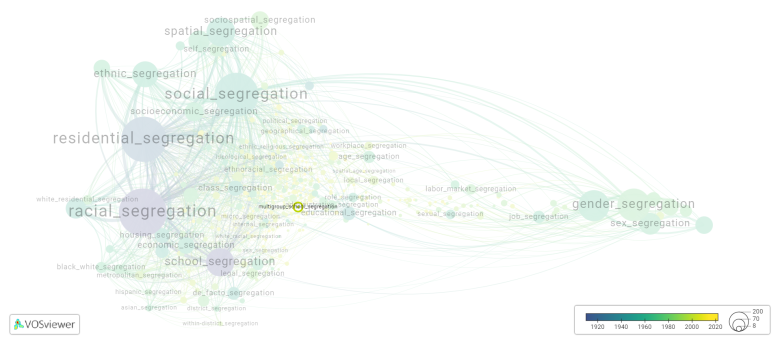Multigroup school segregation: Difference between revisions
(Creating page) |
(Creating page) |
||
| (6 intermediate revisions by the same user not shown) | |||
| Line 1: | Line 1: | ||
===== Date and country of first publication<ref>Date and country of first publication as informed by the Scopus database (December 2023).</ref>===== | |||
2011<br> | 2011<br> | ||
United States | United States | ||
===== Definition ===== | |||
Multi-ethnic spatial segregation refers to the physical separation of different ethnic or racial groups within a particular geographic area. This can manifest in various ways, such as distinct neighborhoods or communities predominantly populated by specific ethnic groups, or barriers like highways or natural landscapes dividing different ethnic populations. | |||
This type of segregation can occur for a variety of reasons, including historical patterns of discrimination and segregation, economic inequalities, and cultural preferences for living among people of similar backgrounds. Multi-ethnic spatial segregation can have negative impacts on social cohesion, access to resources, and opportunities for intercultural exchange and understanding. | |||
Efforts to address multi-ethnic spatial segregation often involve policies and initiatives aimed at promoting diversity, inclusive urban planning, and equitable access to housing and services for all residents. By fostering more integrated and inclusive communities, societies can work towards reducing the negative effects of segregation and promoting greater social harmony and cohesion. | |||
==See also== | ==See also== | ||
==Related segregation forms== | |||
Multigroup school segregation is frequently discussed in the literature with the following segregation forms: | |||
[[school segregation]] | |||
[[File:multigroup_school_segregation.png|780x780px]] | |||
This visualization is based on the study [[Segregation_Wiki:About| The Multidisciplinary Landscape of Segregation Research]]. | |||
For the complete network of interrelated segregation forms, please refer to: | |||
* [https://tinyurl.com/2235lkhw First year of publication] | |||
* [https://tinyurl.com/2d8wg5n3 Louvain clusters] | |||
* [https://tinyurl.com/223udk5r Betweenness centrality] | |||
* [https://tinyurl.com/244d8unz Disciplines in which segregation forms first emerged (Scopus database).] | |||
==References== | ==References== | ||
==Notes== | ==Notes== | ||
<references /> | <references /> | ||
{{NoteAI}} | {{NoteAI}} | ||
== | ==Multigroup school segregation appears in the following literature== | ||
Frankel D.M., Volij O. (2011) Measuring school segregation. ''Journal of Economic Theory'', ''146''(1), 1-38. | Frankel D.M., Volij O. (2011). Measuring school segregation. ''Journal of Economic Theory'', ''146''(1), 1-38. https://doi.org/10.1016/j.jet.2010.10.008 | ||
Latest revision as of 07:17, 16 October 2024
Date and country of first publication[1][edit | edit source]
2011
United States
Definition[edit | edit source]
Multi-ethnic spatial segregation refers to the physical separation of different ethnic or racial groups within a particular geographic area. This can manifest in various ways, such as distinct neighborhoods or communities predominantly populated by specific ethnic groups, or barriers like highways or natural landscapes dividing different ethnic populations.
This type of segregation can occur for a variety of reasons, including historical patterns of discrimination and segregation, economic inequalities, and cultural preferences for living among people of similar backgrounds. Multi-ethnic spatial segregation can have negative impacts on social cohesion, access to resources, and opportunities for intercultural exchange and understanding.
Efforts to address multi-ethnic spatial segregation often involve policies and initiatives aimed at promoting diversity, inclusive urban planning, and equitable access to housing and services for all residents. By fostering more integrated and inclusive communities, societies can work towards reducing the negative effects of segregation and promoting greater social harmony and cohesion.
See also[edit | edit source]
Related segregation forms[edit | edit source]
Multigroup school segregation is frequently discussed in the literature with the following segregation forms:
This visualization is based on the study The Multidisciplinary Landscape of Segregation Research.
For the complete network of interrelated segregation forms, please refer to:
References[edit | edit source]
Notes[edit | edit source]
- ↑ Date and country of first publication as informed by the Scopus database (December 2023).
At its current state, this definition has been generated by a Large Language Model (LLM) so far without review by an independent researcher or a member of the curating team of segregation experts that keep the Segregation Wiki online. While we strive for accuracy, we cannot guarantee its reliability, completeness and timeliness. Please use this content with caution and verify information as needed. Also, feel free to improve on the definition as you see fit, including the use of references and other informational resources. We value your input in enhancing the quality and accuracy of the definitions of segregation forms collectively offered in the Segregation Wiki ©.
Multigroup school segregation appears in the following literature[edit | edit source]
Frankel D.M., Volij O. (2011). Measuring school segregation. Journal of Economic Theory, 146(1), 1-38. https://doi.org/10.1016/j.jet.2010.10.008

